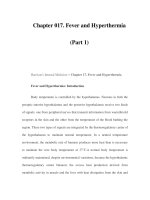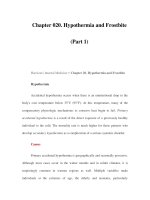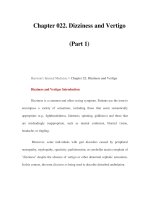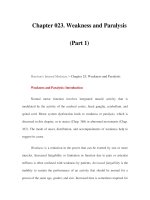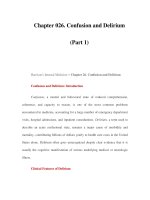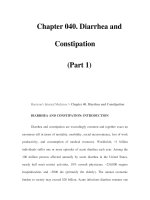Chapter 047. Hypercalcemia and Hypocalcemia (Part 1) docx
Bạn đang xem bản rút gọn của tài liệu. Xem và tải ngay bản đầy đủ của tài liệu tại đây (30.53 KB, 5 trang )
Chapter 047. Hypercalcemia
and Hypocalcemia
(Part 1)
Harrison's Internal Medicine > Chapter 47. Hypercalcemia and
Hypocalcemia
HYPERCALCEMIA AND HYPOCALCEMIA: INTRODUCTION
The calcium ion plays a critical role in normal cellular function and
signaling, regulating diverse physiologic processes such as neuromuscular
signaling, cardiac contractility, hormone secretion, and blood coagulation. Thus,
extracellular calcium concentrations are maintained within an exquisitely narrow
range through a series of feedback mechanisms that involve parathyroid hormone
(PTH) and the active vitamin D metabolite 1,25-dihydroxyvitmin D
[1,25(OH)
2
D]. These feedback mechanisms are orchestrated by integrating signals
between the parathyroid glands, kidney, intestine, and bone (Fig. 47-1) (Chap.
346).
Figure 47-1
Feedback mechanisms maintaining extracellular calcium
concentrations within a narrow, physiologic range [8.9–10.1 mg/dL (2.2–2.5
mM)]. A decrease in extracellular (ECF) calcium (Ca
2+
) triggers an increase in
parathyroid hormone (PTH) secretion (1) via activation of the calcium sensor
receptor on parathyroid cells. PTH, in turn, results in increased tubular
reabsorption of calcium by the kidney (2) and resorption of calcium from bone (2)
and also stimulates renal 1,25(OH)
2
D production (3). 1,25(OH)
2
D, in turn, acts
principally on the intestine to increase calcium absorption (4). Collectively, these
homeostatic mechanisms serve to restore serum calcium levels to normal.
Disorders of serum calcium concentration are relatively common and often
serve as a harbinger of underlying disease. This chapter provides a brief summary
of the approach to patients with altered serum calcium levels. See Chap. 347 for a
detailed discussion of this topic.
HYPERCALCEMIA
Etiology
The causes of hypercalcemia can be understood and classified based on
derangements in the normal feedback mechanisms that regulate serum calcium
(Table 47-1). Excess PTH production, which is not appropriately suppressed by
increased serum calcium concentrations, occurs in primary neoplastic disorders of
the parathyroid glands (parathyroid adenomas, hyperplasia, or, rarely, carcinoma)
that are associated with increased parathyroid cell mass and impaired feedback
inhibition by calcium.
Inappropriate PTH secretion for the ambient level of serum calcium also
occurs with heterozygous inactivating calcium sensor receptor (CaSR) mutations,
which impair extracellular calcium sensing by the parathyroid glands and the
kidneys, resulting in familial hypocalciuric hypercalcemia (FHH).
Although PTH secretion by tumors is extremely rare, many solid tumors
produce PTH-related peptide (PTHrP), which shares homology with PTH in the
first 13 amino acids and binds the PTH receptor, thus mimicking effects of PTH
on bone and the kidney. In PTHrP-mediated hypercalcemia of malignancy, PTH
levels are suppressed by the high serum calcium levels.
Hypercalcemia associated with granulomatous disease (e.g., sarcoidosis) or
lymphomas is caused by enhanced conversion of 25(OH)D to the potent
1,25(OH)
2
D. In these disorders, 1,25(OH)
2
D enhances intestinal calcium
absorption, resulting in hypercalcemia and suppressed PTH.
Disorders that directly increase calcium mobilization from bone, such as
hyperthyroidism or osteolytic metastases, also lead to hypercalcemia with
suppressed PTH secretion, as does exogenous calcium overload, as in milk-alkali
syndrome, or total parenteral nutrition with excessive calcium supplementation.
